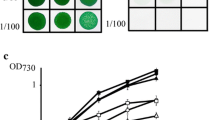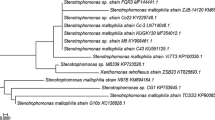Abstract
Over 50 ATP-binding cassette (ABC) transporter-related genes are detected in the Synechocystis sp. PCC 6803 genome by genome sequence analysis. Deletion mutants of other substrate-unknown ABC transporter genes were screened for their acid stress sensitivities in a low-pH medium to identify ABC transporters involved in acid resistance. We found that a mutant of sll1180 encoding proteins with homology to HlyB in Escherichia coli (E.coli) is more sensitive to acid stress than wild-type (WT) cells and analyzed the abundance of expression of the genes in WT cells under acid stress condition by quantitative real-time reverse transcriptase-polymerase chain reaction. sll1180 expression increased in the WT cells after acid stress treatment. Immunofluorescence revealed that Sll1180 localized in the plasma membrane. These results suggest that Sll1180 has an important role in the growth of Synechocystis sp. PCC 6803 under acid stress conditions. HlyB, HlyD, and TolC complex transport HlyA in E.coli; therefore, we searched for genes corresponding to these in Synechocystis sp. PCC 6803. A BlastP search suggested that HlyA, HlyD, and TolC proteins had homology to Sll1951, Sll1181, and Slr1270. Therefore, we constructed deletion mutant of these genes. sll1181 and slr1270 mutant cells revealed acid stress sensitivity. The bacterial two-hybrid analysis showed that Sll1180 interacted with Sll1181 and Sll1951. Dot blot analysis of Sll1951-His revealed that the sll1180 and sll1181 mutant cells did not transport Sll1951-His from the cytoplasm to the extracellular matrix. These results suggest that Sll1180 and Sll1181 transport Sll1951 and that Sll1951—outside of the cells—might be a key factor in acid stress tolerance.






Similar content being viewed by others
Abbreviations
- ABC:
-
ATP-binding cassette
- BACTH:
-
Bacterial two hybrid
- E. coli :
-
Escherichia coli
- QRT-PCR:
-
Quantitative reverse transcription-polymerase chain reaction
- r.t.:
-
Room temperature
- SDS-PAGE:
-
Sodium dodecyl sulfate polyacrylamide gel electrophoresis
- Synechocystis 6803:
-
Synechocystis sp. PCC 6803
- TCA:
-
Trichloroacetic acid
- WT:
-
Wild type
References
Agarwal R, Zakharov S, Hasan SS, Ryan CM, Whitelegge JP, Cramer WA (2014) Structure-function of cyanobacterial outer-membrane protein, Slr1270: homolog of Escherichia coli drug export/colicin import protein, TolC. FEBS Lett 588:3793–3801
Blight MA, Holland IB (1994) Heterologous protein secretion and the versatile Escherichia coli haemolysin translocator. Trends Biotechnol 12:450–455
Claudio B, Flavio B (1998) Soil acidification by acid rain in forest ecosystems: a case study in northern Italy. Sci Total Environ 222:1–15
Costa TR, Felisberto-Rodrigues C, Meir A, Prevost MS, Redzej A, Trokter M, Waksman G (2015) Secretion systems in Gram-negative bacteria: structural and mechanistic insights. Nat Rev Microbiol 13:343–359
Delepelaire P (2004) Type I secretion in gram-negative bacteria. Biochim Biophys Acta 11:149–161
Hihara Y, Kamei A, Kanehisa M, Kaplan A, Ikeuchi M (2001) DNA microarray analysis of cyanobacterial gene expression during acclimation to high light. Plant Cell 13:793–806
Hihara Y, Sonoike K, Kanehisa M, Ikeuchi M (2003) DNA microarray analysis of redox-responsive genes in the genome of the cyanobacterium Synechocystis sp. strain PCC 6803. J Bacteriol 185:1719–1725
Holland IB, Peherstorfer S, Kanonenberg K, Lenders M, Reimann S, Schmitt L (2016) Type I protein secretion—deceptively simple yet with a wide range of mechanistic variability across the family. EcoSal Plus. https://doi.org/10.1128/ecosalplus.ESP-0019-2015
Igarashi K, Kashiwagi K (1999) Polyamine transport in bacteria and yeast. Biochem J 344:633–642
Kaneko T, Sato S, Kotani H, Tanaka A, Asamizu E, Nakamura Y et al (1996) Sequence analysis of the genome of the unicellular cyanobacterium Synechocystis sp. strain PCC 6803. II. Sequence determination of the entire genome and assignment of potential protein-coding regions. DNA Res 3:109–136
Kanesaki Y, Suzuki I, Allakhverdiev SI, Mikami K, Murata N (2002) Salt stress and hyperosmotic stress regulate the expression of different sets of genes in Synechocystis sp. PCC 6803. Biochem Biophys Res Commun 290:339–348
Kobayashi M, Ishizuka T, Katayama M, Kanehisa M, Bhattacharyya-Pakrasi M, Pakrasi HB et al (2004) Response to oxidative stress involves a novel peroxiredoxin gene in the unicellular cyanobacterium Synechocystis sp. PCC 6803. Plant Cell Physiol 45:290–299
Kochian KV (1995) Cellular mechanisms of aluminium toxicity and resistance in plant. Annu Rev Plant Physiol Mol Biol 46:237–260
Kowata H, Tochigi S, Takahashi H, Kojima S (2017) Outer membrane permeability of cyanobacterium Synechocystis sp. strain PCC 6803: studies of passive diffusion of small organic nutrients reveal the absence of classical porins and intrinsically low permeability. J Bacteriol. https://doi.org/10.1128/JB.00371-17
Lecher J, Schwarz CK, Stoldt M, Smits SH, Willbold D, Schmitt L (2012) An RTX transporter tethers its unfolded substrate during secretion via a unique N-terminal domain. Structure 20:1778–1787
Matsuhashi A, Tahara H, Ito Y, Uchiyama J, Ogawa S, Ohta H (2015) Slr2019, lipid A transporter homolog, is essential for acidic tolerance in Synechocystis sp. PCC 6803. Photosynth Res 125:267–277
Mikami K, Kanesaki Y, Suzuki I, Murata N (2002) The histidine kinase Hik33 perceives osmotic stress and cold stress in Synechocystis sp. PCC 6803. Mol Microbiol 46:905–915
Miller JH (1972) Experiments in molecular genetics. Cold Spring Harbor Laboratory, New York
Norling B, Zak E, Andersson B, Pakrasi H (1998) 2D-isolation of pure plasma and thylakoid membranes from the cyanobacterium Synechocystis sp. PCC 6803. FEBS Lett 436:189–192
Ohta H, Shibata Y, Haseyama Y, Yoshino Y, Suzuki T, Kagasawa T et al (2005) Identification of genes expressed in response to acid stress in Synechocystis sp. PCC 6803 using DNA microarrays. Photosynth Res 84:225–230
Oliveira P, Martins NM, Santos M, Pinto F, Büttel Z, Couto NA et al (2016) The versatile TolC-like Slr1270 in the cyanobacterium Synechocystis sp. PCC 6803. Environ Microbiol 18:486–502
Sakiyama T, Ueno H, Homma H, Numata O, Kuwabara T (2006) Purification and characterization of a hemolysin-like protein, Sll1951, a nontoxic member of the RTX protein family from the Cyanobacterium Synechocystis sp. strain PCC 6803. J Bacteriol 188:3535–3542
Sakiyama T, Araie H, Suzuki I, Shiraiwa Y (2011) Functions of a hemolysin-like protein in the cyanobacterium Synechocystis sp PCC 6803. Arch Microbiol 193:565–571
Sakurai I, Mizusawa N, Wada H, Sato N (2007) Digalactosyldiacylglycerol is required for stabilization of the oxygen-evolving complex in photosystem II. Plant Physiol 145:1361–1370
Sangari FJ, Cayón AM, Seoane A, García-Lobo JM (2010) Brucella abortus ure2 region contains an acid-activated urea transporter and a nickel transport system. BMC Microbiol 10:107
Schmitt L, Benabdelhak H, Blight MA, Holland IB, Stubbs MT (2003) Crystal structure of the nucleotide-binding domain of the ABC-transporter hemolysin B: identification of a variable region within ABC helical domains. J Mol Biol 330:333–342
Schulein R, Gentschev I, Schlor S, Gross R, Goebel W (1994) Identification and characterization of two functional domains of the hemolysin translocator protein HlyD. Mol Gen Genet 245:203–211
Silhavy JM, Berman ML, Enquist LW (1984) Experiments with gene fusions. Cold Spring Harbor Laboratory, New York
Sonoda M, Katoh H, Vermaas W, Schmetterer G, Ogawa T (1998) Photosynthetic electron transport involved in PxcA-dependent proton extrusion in Synechocystis sp. strain PCC 6803: effect of pxcA inactivation on CO2, HCO3-, and NO3-uptake. J Bacteriol 180:3799–3803
Stanier RY, Kunisawa R, Mandel M, Cohen-Bazire G (1971) Purification and properties of unicellular blue-green algae (order Chroococcales). Bacteriol Rev 35:171–205
Suzuki I, Simon WJ, Slabas AR (2006) The heat shock response of Synechocystis sp. PCC 6803 analyzed by transcriptomics and proteomics. J Exp Bot 57:1573–1578
Tahara H, Uchiyama J, Yoshihara T, Matsumoto K, Ohta H (2012) Role of Slr1045 in environmental stress tolerance and lipid transport in the cyanobacterium Synechocystis sp. PCC 6803. Biochim Biophys Acta 1817:1360–1366
Tahara H, Matsuhashi A, Uchiyama J, Ogawa S, Ohta H (2015) Sll0751 and Sll1041 are involved in acid stress tolerance in Synechocystis sp. PCC 6803. Photosynth Res 25:233–242
Thanabalu T, Koronakis E, Hughes C, Koronakis V (1998) Substrate-induced assembly of a contiguous channel for protein export from E.coli: reversible bridging of an inner-membrane translocase to an outer membrane exit pore. EMBO J 17:6487–6496
Tsunekawa K, Shijuku T, Hayashimoto M, Kojima Y, Onai K, Morishita M et al (2009) Identification and characterization of the Na+/H+ antiporter NhaS3 from the thylakoid membrane of Synechocystis sp. PCC 6803. J Biol Chem 284:16513–16521
Uchiyama J, Asakura R, Kimura M, Moriyama A, Tahara H, Kobayashi Y et al (2012) Slr0967 and Sll0939 induced by the SphR response regulator in Synechocystis sp. PCC 6803 are essential for growth under acid stress conditions. Biochim Biophys Acta 1817:1270–1276
Uchiyama J, Asakura R, Moriyama A, Kubo Y, Shibata Y, Yoshino Y et al (2014) Sll0939 is induced by Slr0967 in the cyanobacterium Synechocystis sp. PCC 6803 and is essential for growth under various stress conditions. Plant Physiol Biochem 81:36–43
Uchiyama J, Kanesaki Y, Iwata N, Asakura R, Funamizu K, Tasaki R et al (2015) Genomic analysis of parallel-evolved cyanobacterium Synechocystis sp. PCC 6803 under acid stress. Photosynth Res 125:243–254
Wandersman C, Delepelaire P (1990) TolC, an Escherichia coli outer membrane protein required for hemolysin secretion. Proc Natl Acad Sci USA 87:4776–4780
Wang R, Seror SJ, Blight M, Pratt JM, Broome-Smith JK, Holland IB (1991) Analysis of the membrane organization of an Escherichia coli protein translocator, HlyB, a member of a large family of prokaryote and eukaryote surface transport proteins. J Mol Biol 217:441–454
Zhang F, Sheps JA, Ling V (1993) Complementation of transport-deficient mutants of Escherichia coli alpha-hemolysin by second-site mutations in the transporter hemolysin B. J Biol Chem 268:19889–19895
Zhang P, Battchikova N, Jansen T, Appel J, Ogawa T, Aro EM (2004) Expression and functional roles of the two distinct NDH-1 complexes and the carbon acquisition complex NdhD3/NdhF3/CupA/Sll1735 in Synechocystis sp. PCC 6803. Plant Cell 16:3326–3340
Zhang X, Chen G, Qin C, Wang Y, Wei D (2012) Slr0643, an S2P homologue, is essential for acid acclimation in the cyanobacterium Synechocystis sp. PCC 6803. Microbiol 158:2765–2780
Acknowledgements
This study was supported by the Program for Development of Strategic Research Center in Private Universities, which was supported by MEXT.
Author information
Authors and Affiliations
Corresponding author
Electronic supplementary material
Below is the link to the electronic supplementary material.
Rights and permissions
About this article
Cite this article
Uchiyama, J., Itagaki, A., Ishikawa, H. et al. Characterization of ABC transporter genes, sll1180, sll1181, and slr1270, involved in acid stress tolerance of Synechocystis sp. PCC 6803. Photosynth Res 139, 325–335 (2019). https://doi.org/10.1007/s11120-018-0548-2
Received:
Accepted:
Published:
Issue Date:
DOI: https://doi.org/10.1007/s11120-018-0548-2




